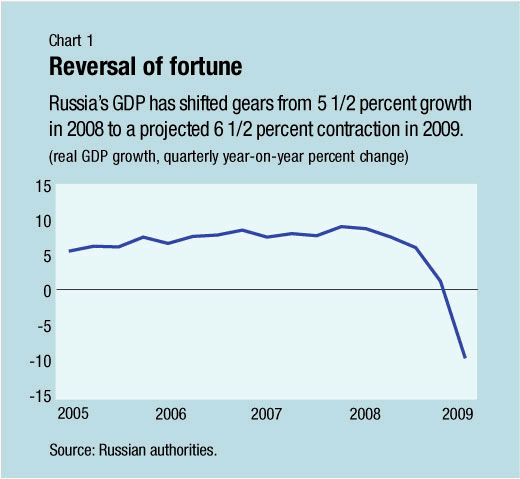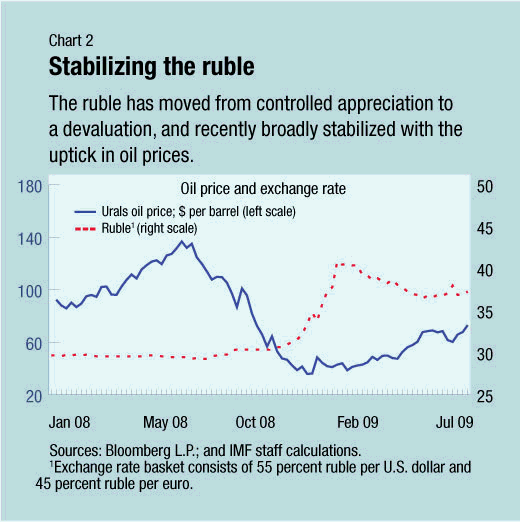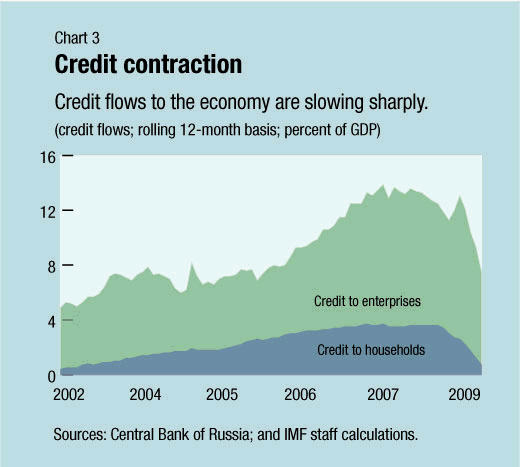
Typical street scene in Santa Ana, El Salvador. (Photo: iStock)
IMF Survey: Russia Needs to Bolster Banks, Target Fiscal Stimulus
August 7, 2009
- Economy will begin slow recovery in 2010 after 6.5 percent decline in 2009
- Proactive, comprehensive response to banking sector problems needed
- Fiscal stimulus should target self-reversing measures
Russia has been hit hard by dual shocks—a collapse in oil prices and a sudden reversal of capital flows.

Bank sign in Moscow, Russia, where authorities have strengthened bank supervision, monitoring of systemic risk (photo: Alexei Filippov/Itar-Tass)
ECONOMIC HEALTH CHECK
Even though Russia’s far-sighted policy of saving most oil revenues allowed for a large fiscal stimulus, the IMF in its annual Article IV assessment of the country’s economy projects real GDP to turn from 5½ percent growth in 2008 to a contraction of 6½ percent in 2009, followed by only a tepid recovery in 2010 (see Chart 1).
Fixed investment has plummeted, weakening the nexus of high rates of growth in investment, productivity, and real wages that had powered Russia’s consumption and output boom before the crisis. Unemployment has skyrocketed to an eight-year high, dampening growth in real wages. Banks have come under increased strain, and private sector credit has contracted.

So, the authorities now face two key challenges:
• fortifying the banking system; and
• balancing short- and medium-term fiscal considerations.
These tasks must be viewed against the background of pre-crisis policies.
Credit boom
The crisis has highlighted some of the strengths and weaknesses in Russia’s pre-crisis policies.
Russia’s prudent policy of taxing and saving much of its oil wealth during the good years has left it in a strong position. Despite some weakening of fiscal policy discipline in recent years, the budget was still balanced at an oil price of just half the world market price when the crisis hit. This allowed the government to undertake a large fiscal stimulus to support domestic demand. Moreover, Russia’s sizable reserves, fortified by the oil savings of some 16½ percent of GDP, initially allowed the central bank to cushion the impact of the crisis by easing monetary policy.
That said, the pre-crisis policy of controlled appreciation of the ruble had contributed to excessive foreign currency borrowing, as high oil prices helped inflate investor appetite for Russian assets. The result was an oil price-related surge in capital inflows and an associated credit boom, which led to overheating and left Russian banks and corporates vulnerable to a reversal of inflows.
Tackling the crisis
The government’s initial policy response in late 2008 was swift and substantial. It was driven by concerns that weaknesses in the banking and corporate sectors could lead to a full-fledged crisis. Policy interventions focused at first on maintaining stability in the external and financial sectors.
The central bank provided substantial liquidity at low interest rates, and drew down its large reserves to offset the abrupt loss of foreign financing. But as reserve losses mounted and capital outflows surged, the ruble was ultimately devalued and the monetary stance was tightened (see Chart 2). The exchange rate quickly stabilized and reserve losses abated.

More recently, as oil prices have increased, the exchange rate has appreciated and modest capital inflows have resumed. As inflation pressures have moderated in the wake of the economic downturn, monetary policy has gradually been eased.
Banking sector under strain
With economic activity plummeting and in the context of an abrupt monetary tightening earlier in the year, overdue loans have more than doubled since January. At the same time, high economic uncertainty has induced banks to hoard liquidity. As a result, credit flows are slowing, while the stock of credit has fallen for the first time since end-2004 (see Chart 3).
The situation in the banking sector is expected to continue to deteriorate. Overdue loans are expected to increase sharply over the course of the year, weakening capital adequacy. The key immediate test facing Russian policymakers is how to deal with these mounting problems.
Fortifying banks
In recent years, the Central Bank of Russia has made significant progress in strengthening its supervision of banks and monitoring of systemic risks. These improvements have undoubtedly facilitated its crisis response. In addition, the government has set aside some Rub 500 billion ($16 billion) to support bank recapitalization, taken some steps to improve bank resolution, and increased the deposit-insurance limit.

But more needs to be done. The IMF recommended that the authorities reinforce these measures by undertaking mandatory, bottom-up stress tests of larger banks to better understand their financial health. It also underscored the importance of contingency planning to bolster the authorities’ ability to proactively address potential problems in the banking system.
Effective fiscal stimulus
In response to the sharp economic downturn, the government introduced a large fiscal stimulus. A supplementary budget passed in April includes sizable discretionary increases in defense and security spending, support to strategic sectors, and social assistance, alongside tax reductions. Reflecting the stimulus, the non-oil deficit of the general government is expected to widen by 5½ percentage points in 2009, reaching 13¾ percent of GDP—some 11 percent of GDP above the level prescribed by the authorities’ medium-term framework, when pension costs are included.
While a fiscal stimulus is certainly justified now, concerns about its reversibility and effectiveness argue for limiting the size of the stimulus and focusing on self-reversing items. Fiscal policy had become increasingly procyclical before the crisis and a number of important reforms that could have generated significant fiscal savings were delayed. This history raises concerns that the large deficits become entrenched. Failure to reverse the stimulus once the economy recovers could fuel a renewed bout of excessive real appreciation, threatening Russia’s ability to diversify its economy away from primary commodities.
Given these considerations, the IMF recommended a smaller, but better targeted, stimulus. The effectiveness of the stimulus could be improved by increasing transfers to the poor and frontloading “shovel-ready” infrastructure projects. These expenditures tend to have high fiscal multipliers, implying a larger impact on growth. Thus, the good news is that a better targeted, yet smaller, stimulus could have a similar impact on economic activity without compromising competitiveness when the economy recovers.
Comments on this article should be sent to imfsurvey@imf.org







